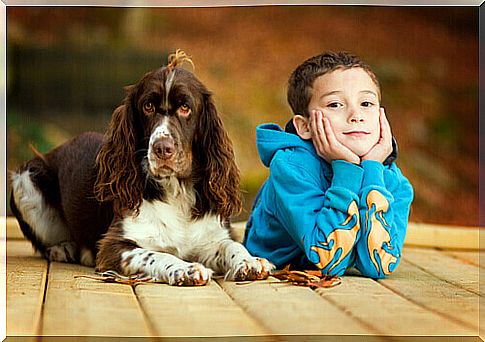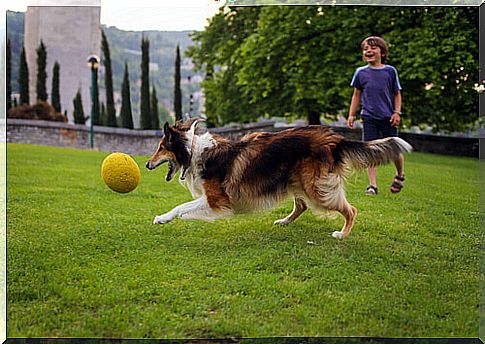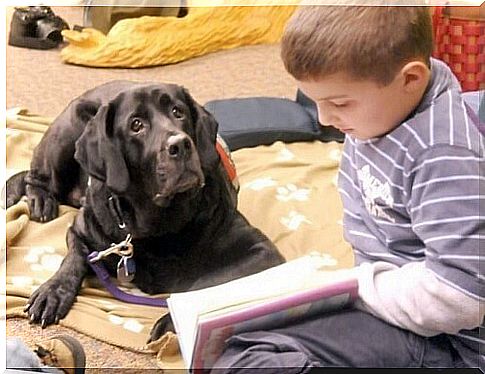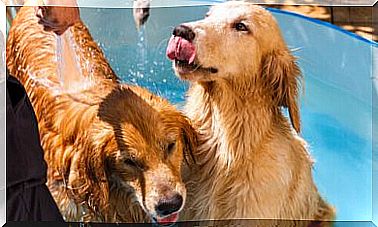Dogs That Go To Class And Help The Children

The dog is man’s best friend. And he is also the best friend and greatest ally of children. The benefits that children derive from animals, especially dogs, are numerous and varied. For this reason, the training of dogs for pedagogical and therapeutic use is more and more extensive and regulated.
Dogs that go to class: a help for all children

Certainly more popular are cases in which dogs are trained to assist children with Autism Spectrum Disorder (ASD), mobility problems, Down’s Syndrome, with general difficulties in social interaction or who need to work on managing their own. aggression and anger.
However, the use of these animals for pedagogical purposes in classrooms with children without any particular conditions is an increasingly popular trend.
Specialists who promote the presence of dogs in schools say they help all children improve concentration and make learning more fun. Furthermore, canine collaboration is particularly useful in aspects such as reading or numerical comprehension.
Dogs reduce the stress of children
The success of dogs as a learning tool in the classroom is intimately related to various researches, which led to the conclusion that these animals drastically reduce the stress of children.
Situations that generate great tension, such as reading in public or being questioned, in the company of a dog can become tolerable and perfectly manageable experiences.
The same principle was applied in cases of children who required special attention. The results have been more than positive.
Communication bridge between children and their surroundings
Since the mid-90s, dogs have been used in the most diverse sectors. They are of particular help so that children with autism are able to relate to their surroundings, socialize and improve their quality of life in general (and that of their family members).
Part of the help is to accompany children as they face new experiences , which can be highly stressful, such as going to school.
The benefits for children
Numerous specialists combine psychotherapy with the presence of a dog to help children with Autism Spectrum Disorder. Among the numerous benefits of this practice the following stand out:
Reduction of escape attempts
A latent risk that the parents of autistic children and those who work with them face. A vital part of the training these animals receive is to physically block any escape attempts that may arise.
When dogs are assigned to work in such cases, in specific situations, such as going to or leaving school, they must be tied to the child’s belt. If the child tries to escape, the accompanying dog will lie down on the ground. Over time, the specialists assure us, these behaviors will decrease until they disappear completely.
Tolerance and frustration management
Dogs help little ones tolerate and manage frustration. When a child with autism finds himself dealing with a situation that is unpleasant and causes him excessive distress, he usually responds with screams and other gestures such as strong hand movements. Being in the company of the dog, these reactions generated by tension are progressively reduced.
They stimulate communication
Getting eye contact with people with this condition is quite difficult. However, by working with dogs, children gradually establish such contact with the people around them. They also adopt other forms of verbal and non-verbal communication.
Generally speaking, dogs motivate them. They become responsible for these children’s social interaction skills, as well as their attention, concentration and self-esteem. Specialists recommend getting your child to work with the dog assigned to him as soon as possible, preferably as soon as he turns 3 years old.
Other therapeutic and pedagogical experiences

As for children with mobility problems, dogs accompany them to school and at other times of the day they are much more than their carers.
Most dogs, especially when trained for this purpose, are excellent babysitters. On the other hand, children easily get in tune with animals in general. The instinct for protection and collaboration, as well as this natural empathy between the little ones and the dogs, can be enhanced to the maximum, obtaining results that to many may seem simply surprising.









